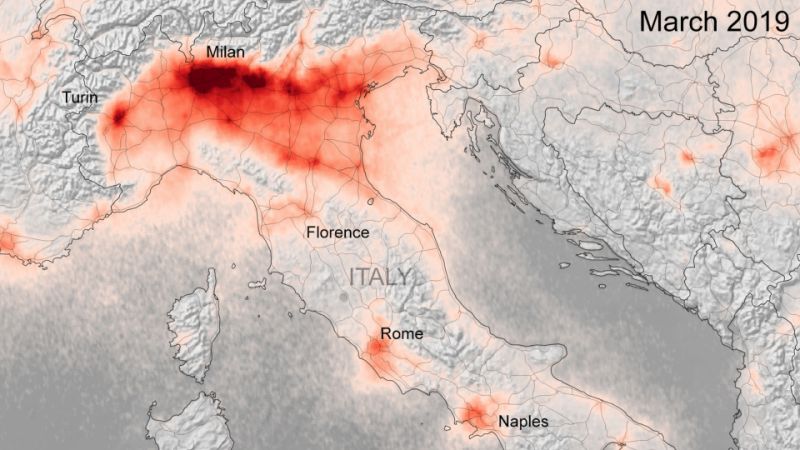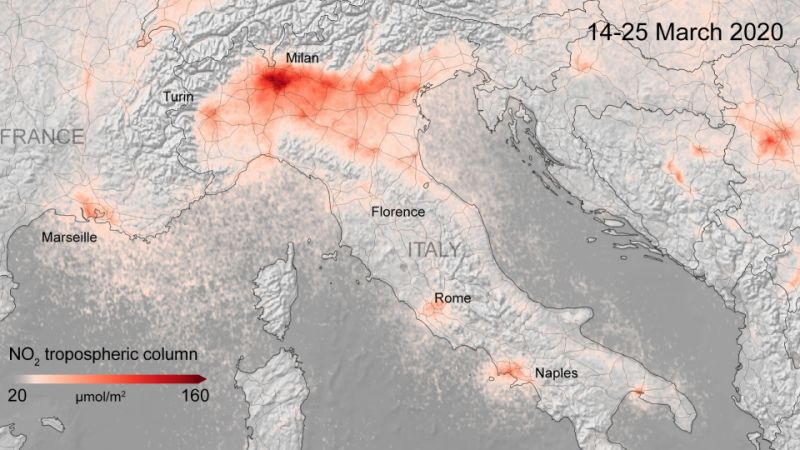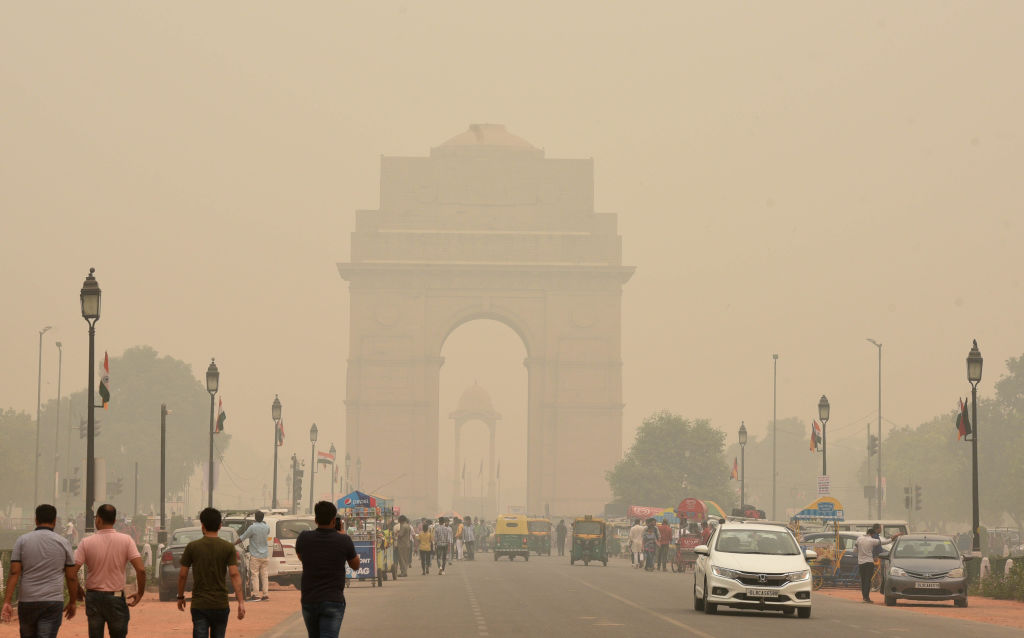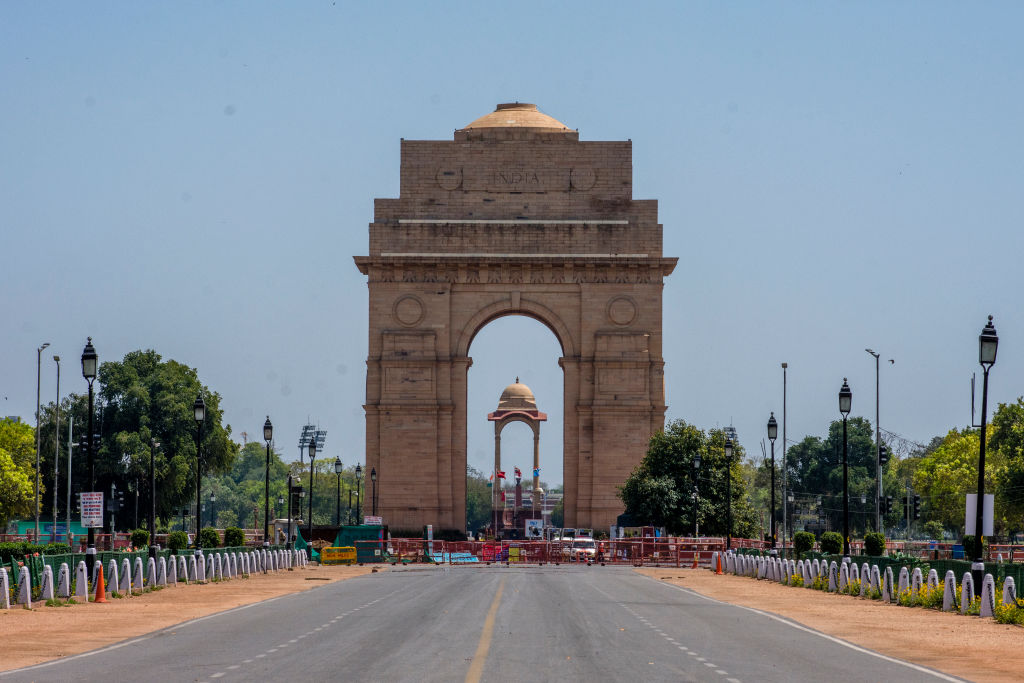This is Italy in March last year:

And this is Italy in March this year, once lockdowns began:

These images from the Copernicus Sentinel-5P satellite which has been monitoring NOx levels in Europe show significant differences. As of March 25, Italian cities such as Milan and Bergamo saw nitrogen dioxide (NO2) concentrations down by a 21 percent and 47 percent respectively. Rome’s average NO2 concentrations for the four weeks preceding March 25 were down between 26 and 35 percent, compared to the same weeks in 2019.
The changes over northern Italy are particularly striking because smoke from a dense cluster of factories tends to get trapped against the Alps at the end of the Po Valley, making this one of western Europe’s pollution hot spots.
Spanish figures seem to follow similar trends. Average NO2 levels in Barcelona were down 55 percent for the same mid-March period, compared with 2019. Compared with the week prior, levels were down 40 percent.
One of the largest drops in pollution levels could be seen over the city of Wuhan, the capital of Hubei province which more than 50,000 coronavirus cases and was put under a strict lockdown in late January. The city is a transport hub that is home to more than 11 million people and a major engine of growth in the world’s second largest economy. According to Nasa, NO2 levels across eastern and central China have been 10-30 percent lower than normal.
In the world’s largest Lockdown that started last week in India, data shows that the main cities are recording much lower levels of harmful microscopic particulate matter known as PM 2.5, and of NO2. PM2. 5 (particles less than 2.5 micrometers in diameter) can penetrate deeply into the lung, irritate and corrode the alveolar wall, and consequently impair lung function, causing serious health risks.
In the capital, New Delhi, government data shows the average concentration of PM 2.5 plunged by 71 percent in the space of a week -- falling from 91 microgram per cubic meter on March 20, to 26 on March 27, after the lockdown began. The World Health Organization considers anything above 25 to be unsafe. NO2 went from 52 per cubic meter to 15 in the same period -- also a 71 percent fall. Mumbai, Chennai, Kolkata and Bangalore have also recorded a fall in these air pollutants.
The sudden fall in pollutants marks a significant shift for Indians who get look up to blue as the heavy, grey smog clears. The country has 21 of the world's 30 most polluted cities, according to the IQAir AirVisual's 2019 World Air Quality Report.


Nitrogen dioxide is produced from car engines, power plants and other industrial processes and is thought to exacerbate respiratory illnesses such as asthma. The World Health Organization describes NO2 as “a toxic gas which causes significant inflammation of the airways” at concentrations above 200 micrograms per cubic meter. Pollution particles may also be a vector for pathogens, as well as exacerbating existing health problems. The WHO is now investigating whether airborne pollution particles may be a vector that spreads Covid-19 and makes it more virulent, according to an article by The Guardian.
Experts say that this involuntary experiment is a lesson that is desperately needed in India.
In November last year, hundreds of Indians took to the streets in New Delhi to protest the levels of air pollution, after the city was blanketed in a dark yellow haze for several days as air pollution hit record levels. As air quality deteriorated into the "hazardous" category, with the potential to cause respiratory illnesses, schools were ordered to close, construction was halted and flights were diverted. Other cities in northern India also suffered.
Today, the skies are now clearing up, but the impact of living in chronic air pollution polluted conditions has left a hidden problem for residents: a potential vulnerability to the coronavirus pandemic. The country already has the largest cohort of people in the world living with respiratory disease and high rates of tuberculosis. “Such conditions make this densely populated country the perfect fodder for a virus that attacks the lungs of its victims,” writes Vidya Krishnan in Foreign Affairs.
8 million people per year die early from air pollution exposure. This amounts to more deaths than diarrheal disease, tuberculosis and HIV/AIDS combined. This means that people living in cities and other urban areas, and those exposed to toxic fumes, may be more vulnerable to respiratory infections, such as Covid-19, due to related underlying health damage.
“Increased pollution increases susceptibility to infection,” Dr. Meredith McCormack, a spokeswoman for the American Lung Association and associate professor of pulmonary and critical care at Johns Hopkins University told the New York Times. “All things being equal, a person exposed to air pollution would likely have a worse outcome if they were exposed to coronavirus.”
There is evidence from previous coronavirus outbreaks that those exposed to poor air quality are at a higher risk of dying. Scientists who studied the SARS coronavirus outbreak in 2003 found that infected patients from regions with higher air pollution were 84% more likely to die than those in less-polluted areas. Health scientists also point to of research showing people who smoke or breathe dirty air are at higher risk of contracting pneumonia caused by similar viruses and of developing more severe symptoms once they have it.
Breathing unclean air is also linked to high blood pressure, diabetes, conditions that doctors are associate with higher death rates for COVID-19. Physicians say that people with these chronic conditions may be less able to fight off infections and more likely to die of the disease.
Sadly, even though pollution is down for now, chronic exposure can’t be repaired so quickly. For a person living with daily pollution exposure, the damage to their respiratory and immune system is done. “The air may be clearing in Italy, but the damage has already been done to human health and people’s ability to fight off infection,” said Sascha Marschang, acting secretary general of the European Public Health Alliance, in a statement.
Moreover, the blue skies are unlikely to last forever. As the temporary reduction in global CO2 emissions will likely be reversed when industries eventually reopen and crank up production to make up for lost time, air pollution could also bounce back with a vengeance when lockdowns measures are lifted and factories and road traffic go back to their pre-coronavirus state.
But the changes we see today could still have a more persistent effect. As more links are found between air pollution and COVID-19 symptoms, the air we breathe is likely to gain even more attention in the months and years to come. Clearing the air could help many people fight off the threat of deadly disease — during this pandemic as well as any future ones — and save millions of lives in the meantime.









